Dewalt Safety Boots for Long Hours of Hard Wear (Reviews) 2023
Safety boots aren’t just a nice thing to have, they’re often a requirement at the workplace. And no manufacturer knows the demands of the workplace better than DeWALT.
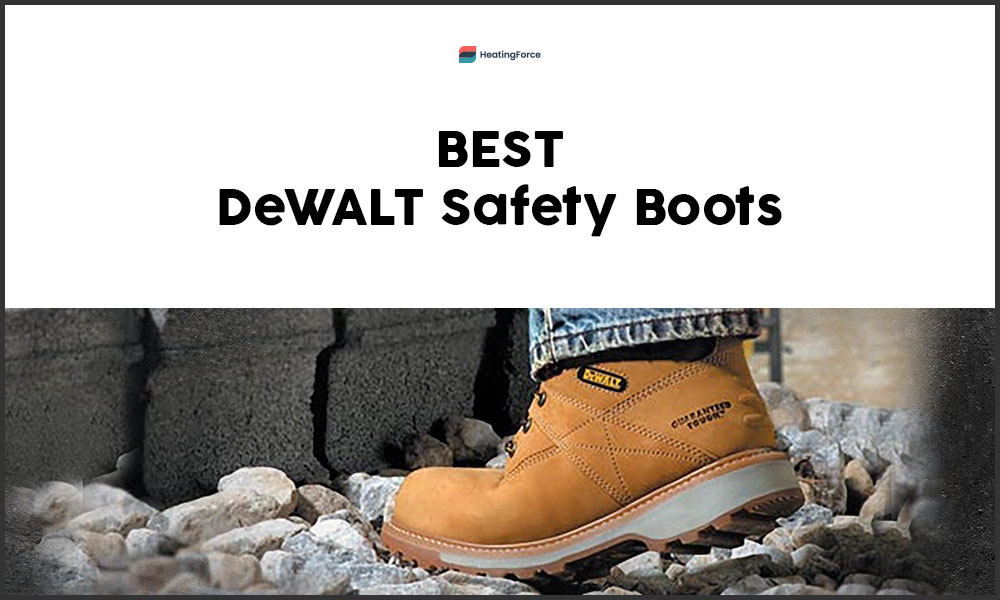
Today, we’re taking a look at the best DeWALT work boots on the market, and talking about what makes a great boot great.
The top 7 DeWalt safety boots
When it comes to your safety, nothing less than the best will do. You need the most durable materials, the best construction, and hard-wearing designs that will meet or exceed the safety standards your workplace demands.
Below, we review the seven best safety boots from industry leaders, DeWalt
1. DeWalt Titanium Safety Boot
If money’s no object and you’re in need of a do-everything work boot, you owe it to yourself to give DeWalt’s Titanium line a look. A relative newcomer to the scene, Titanium is part of the Heritage Series, which makes its mark by never cutting corners on design, materials, or production.
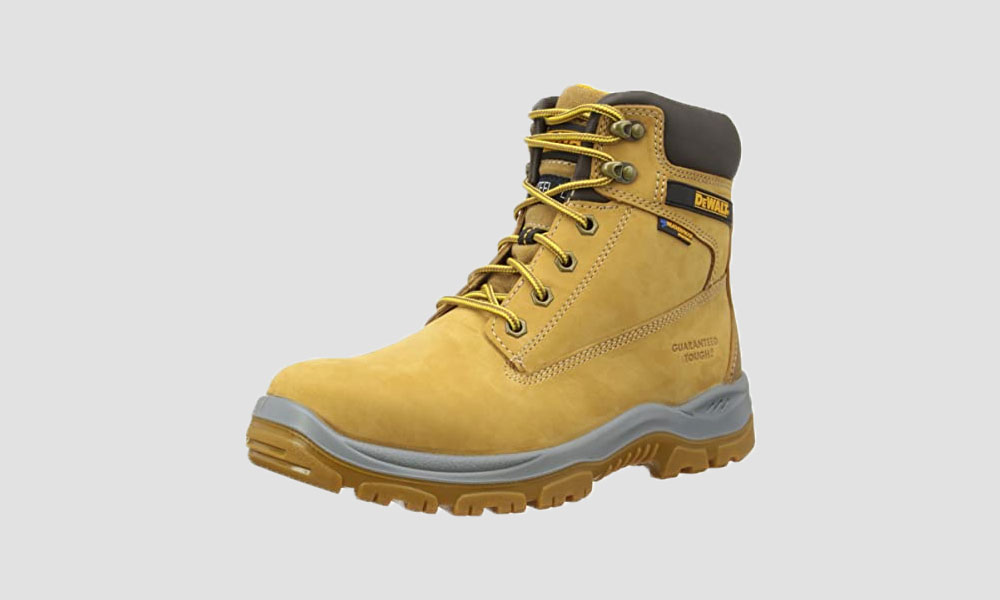
The hardwearing Titanium safety boot features quality from the ground up. It starts with a rugged dual-density TPU outsole, which is highly resistant to oil, slipping, splitting, abrasion, or deformation. Layered above is a PU insole, rated for comfort and long-term durability. Enclosing the whole shebang is a full-grain Nubuck leather upper–the kind of material that shrugs off abuse and looks great doing it.
Better yet, the Titanium is waterproofed through the use of SympaTex’s advanced inner lining. This fabric does a great job keeping moisture out; but still allows your boot to breath, increasing comfort and longevity whilst cutting down on odour and bacteria. The tongue is gusseted to keep out water and debris, and along with the collar is well-padded to ensure a snug, secure fit.
So, the Titanium’s rugged, but that’s nothing if it doesn’t protect your feet. But that it does exceedingly well, with steel in both the toe cap and embedded within the PU midsole. As an American boot, it conforms with that country’s safety standards with full ASTM compliance, rating well vs. impact, compression, and electrical hazards. (This is equivalent to Europe’s EN 345 standard).
Titanium at a glance
- Waterproof
- Oil, slip, abrasion, puncturing, odour, and bacteria resistant
- Steel toe cap and midsole for complete protection
- Highly durable and comfortable
What people are saying about Titanium safety boots
As one of the best-selling safety boots on the market, DeWalt’s Titanium has plenty of people to vouch for their performance in the field. The consensus is that they’re easy to wear in, and extremely sturdy without being too heavy (just 2.4kg).
DeWalt’s sizing is generally accurate for most feet, though some people report Titanium is a bit narrow despite coming in E sizing. The steel/TPU insole is meant to be thick and highly protective, but this isn’t always to everyone’s tastes. Of course others sleep standing up in these things, so view it as a feature rather than a bug!
They’re not cheap, but they’re tough as nails and look great. With a 1-year warranty from DeWalt, you get a guarantee they won’t crap out on the job–or your money back.
2. DeWalt Hammer Soft Toe Work Boot
If you’re looking for rugged protection without a steel toe cap, the DeWalt Hammer Soft Toe Work Boot is for you. Rather than using traditional steel to protect your feet, DeWalt here makes use of a TPU composite toe cap.
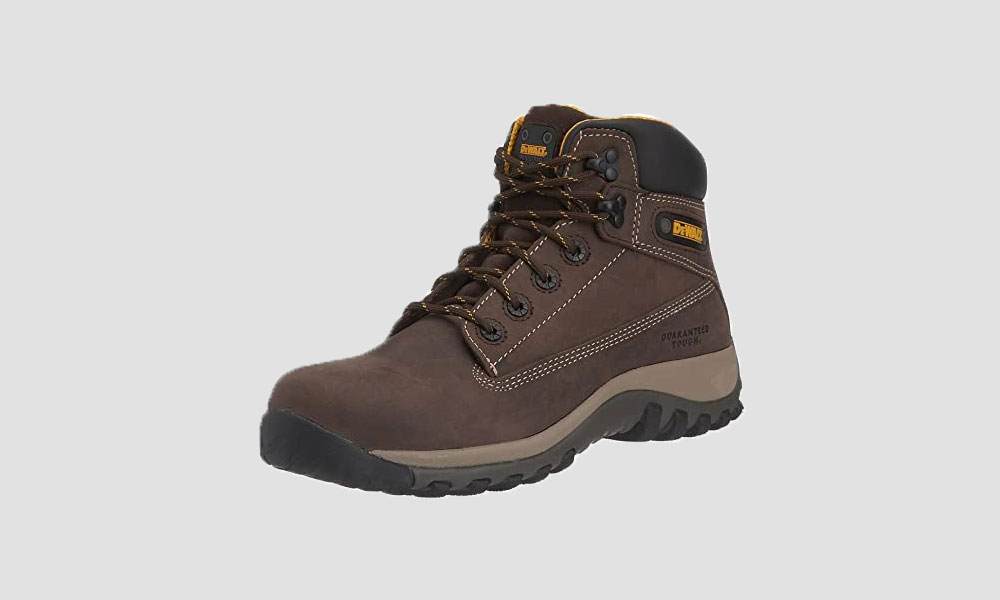
The primary advantages are enhanced electrical resistance, greater thermal insulation, and invisibility to metal detectors. Of course, TPU also makes for a much lighter, more walkable boot for those of you who need to hoof it several miles per day.
But there are many safety boots which don’t use steel, so what makes DeWalt’s Hammer special? How about the brown crazy horse leather upper–the same hardwearing stuff they use in horse saddles. Not only is it tough as nails, it’ll look great as it ages, making you look forward to putting your boots on in the morning.
The Hammer features a durable, dual-layer outsole made of Phylon and rubber. This design offers S3-level protection, and rates this boot as the ideal choice for outdoor work. Provisions include antistatic resistance, resilience against oil and fuel, and protection vs. penetration and impact. What’s more, you won’t have to worry about sliding around slick surfaces.
For added comfort, DeWalt has chosen an EVA midsole for the Hammer, which moulds to your feet and effectively absorbs shock. You’ll also love the moisture-wicking inner lining, which you can remove to air out, wash, or replace as needed to refresh your boot after a hot, sweaty day. The whole inside is well-padded, and similarly includes padded collar for a snug fit.
DeWalt Hammer at a glance
- TPU composite toe cap
- Great electrical and thermal resistance
- Lightweight, yet strong
- Removable moisture-wicking inner linings
What people are saying about Hammer safety boots
These are great boots for when powerful protection is needed, but you can’t have metal weighing you down. DeWalt’s design for the Hammer is clearly rated for hard service, and it’s not unusual to get two or more years of life out of a single pair. Whether you’re a plumber, electrician, or mechanic, you’ll find ample resistance against the hazards of the job.
The Hammer’s soft toe and EVA midsole allow for a lightweight boot (just 1.8kg), and you wouldn’t be uncomfortable walking 10 miles a day or more in these. The tough, full-grain leather does take a little bit of time to break in, but once they do you’ll never find a better fit. That said, if you’re a half size, you’ll probably want to size up; the crazy horse leather isn’t going to stretch a whole lot!
3. DeWalt Rigger
Unlike many rigger boots which flood the market as fashion items, the DeWalt Rigger work boots are the real deal. Conforming to EN-345 safety standards, these feature both a steel toe and ample ankle support, guarding you on the job.
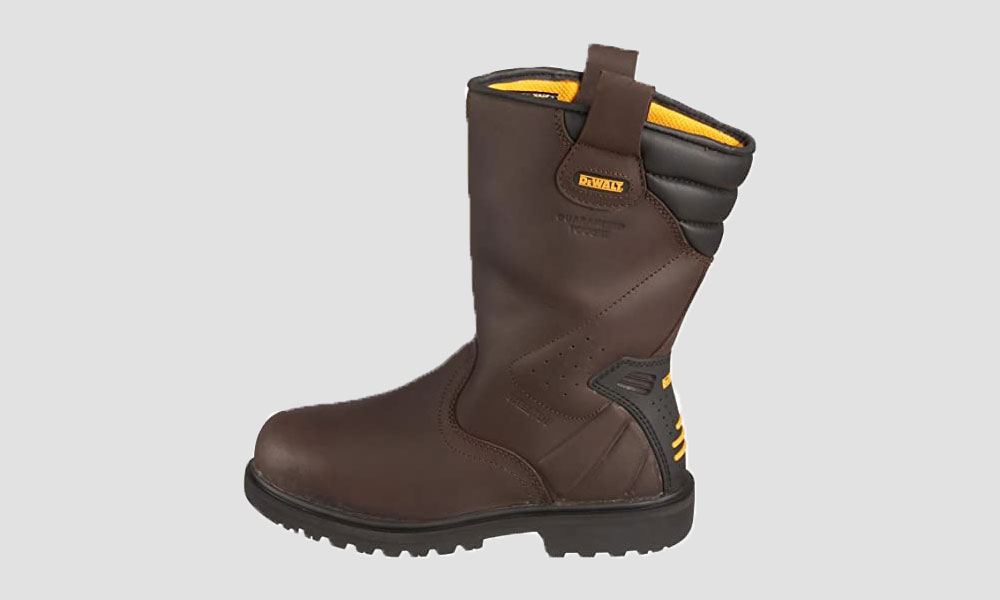
That’s not to say DeWalt doesn’t spare a thought for aesthetics, as their Rigger boots sport rugged good looks that wear hard. Featuring a brown, full-grain leather upper, joined by a rubber outsole, the rigger offers coverage and resistance to oil and chemical exposure. The Goodyear welt makes it simple to replace the soles once they’ve worn out, allowing you to get a lot more life out of those high-quality uppers.
Under the hood, there’s a sturdy, penetration-resistant steel midsole to complement the steel toe box. What’s more, you don’t have to worry about rolling the boot as there’s padded TPU heel support built right in. There’s more padding on the cuff for a comfortable fit, flanked by dual bootstraps for easy donning.
DeWalt Rigger at a glance
- EN-345 compliant
- Oil and chemical resistant
- Steel toe and midsole
- Ankle support
- Goodyear welt
- Unisex
What people are saying about Rigger safety boots
The DeWalt Rigger is a best-selling boot, and provide an excellent, rugged alternative to Wellington style boots. They’re unisex, and can be comfortably worn by anyone; just keep in mind that you might need to size up if you’re on the fence, as they offer a tight fit by design.
It’s also important to be aware that the Rigger’s rubber insole has not been tested for heat resistance. If this is important to you, the Goodyear welt allows for HRO sole replacements. But, you might be better off considering another boot, as well.
Be aware though, as these are such popular boots, many counterfeits are flooding the market. This is especially true in online marketplaces like Amazon, where many vendors may supply a legitimate listing. If you find your steel toe wears through in a month or two, contact support to get your refund. Real DeWalt Riggers are guaranteed for a full year, and should last much longer than that!
4. DeWalt Builder
The Builder safety boot from DeWalt is a highly walkable boot that won’t break the bank. While this is one of the humbler recommendations on our list in terms of features, it nevertheless provides exceptional comfort and a good level of protection for your pound.
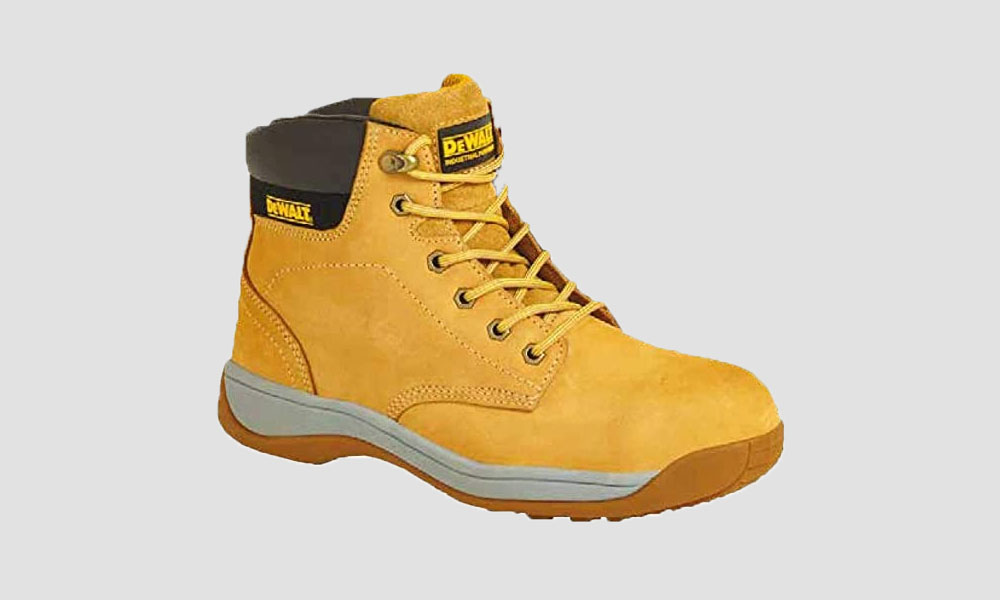
The uppers are made of sturdy, attractive full-grain leather with Nubuck finish. Thus, the Builder withstands abrasion whilst looking no worse for the wear. The synthetic outer sole bears the HRO marking, offering resistance to heat up to 300° C. The tread has good grip on slippery surfaces, though the Builder doesn’t bear an SRA rating.
Perhaps the Builder’s best quality is inside, wherein moisture-wicking liner keeps your boots fresh and odour-free, even through the heaviest duty. What’s more, the dual-density insole moulds to your feet whilst providing exceptional support. Its construction is anti-bacterial in nature, as well, so you never have to worry about conditions getting too swampy in your boot.
The Builder’s midsole consist of EVA, which works a treat to absorb the shock of walking many miles a day. There’s also great heel support, so you can retain steady footing even on uneven terrain. You’ll also love the snug fit afforded by the padded collar and tight-lacing closure, which features brass facings for rust-resistance and longevity.
DeWalt Builder at a glance
- Steel toe, EVA midsole
- Great price
- Moisture-wicking, anti-bacterial
- Great fit
- HRO
- Durable
What people are saying about Builder safety boots
On its own merits, the Builder is a great safety boot. However, its name is somewhat misleading, as actual builders really require a steel midsole. The EVA midsole just isn’t going to withstand a nail puncturing through, which can be a real deal breaker. It does have a steel toe, so there’s still protection from a vast array of crushing hazards; but the midsole is something to think about.
Still, for the price, it’s hard to argue that this is anything other than a rugged, handsome boot. DeWalt obviously put plenty of thought into making this a long-lasting boot, with quality leather uppers, HRO soles, and moisture-wicking inner lining. And if you’ve got many miles to go, you’ll appreciate the TPU heel and EVA midsole, both of which absorb the energy of your footfall and provide flexible, sturdy support.
If you’ve got wide feet, it is recommended to size up, as DeWalt’s Builder is a bit narrow at the toes.
5. DeWalt Poseidon
With a name like Poseidon, you’d expect something like a Wellington boot. While that’s certainly not the case here, DeWalt is still offering us a water-resistant safety boot, with a build rugged enough to live up to its namesake.

True to form for DeWalt, Poseidon features tough-as-nails full-grain leather uppers. These feature a heavy wax finish, which not only forms an effective hydrophobic barrier, but also adds to the extreme longevity these boots are famous for. But with Poseidon, durability goes hand-in-hand with comfort.
It starts with the dual-density insole, which marries extreme hard-wearing PU with a special memory foam that cradles your feet with support as you walk, lift, and climb. Beneath that is an injection-moulded Phylon midsole, offering powerful abrasion resistance and superior energy absorption. Finally, it comes together upon dual PU/rubber outsoles, which feature SRA slip resistance and 300° heat resistance.
If you’re looking for a secure fit, Poseidon’s got it. There’s plenty of heel support and padding around the ankle, further secured by a tough YKK side zipper and leather collar strap. Even the steel toe cap features an ergonomic design which doesn’t crowd or pinch your toes. And despite all the fittings and durable materials, Poseidon is surprisingly breathable inside, making it the ideal choice for all-day wear.
DeWalt Poseidon at a glance
- SRA anti-slip
- HRO
- Triple layer comfort and stability (Phylon, PU, memory foam)
- YKK zipper and collar strap for best fit
- Water resistant
- Long-lasting
What people are saying about Poseidon safety boots
While not quite the hot seller Titanium is, Poseidon has legions of fans who swear by these as the best boot they’ve ever owned. DeWalt’s naming convention again may lead to false impressions about what this boot can do and who it’s for. But it nevertheless easily earns its place on our list of the best safety boots.
As with many of the most durable boots, the leather is necessarily a bit stiff to star, and thus requires a bit more breaking in. However, once you get past this, the honeymoon phase lasts until they wear out utterly; at which point, we’d be surprised if you didn’t immediately order up your next pair of Poseidons!
6. DeWalt Apprentice
Hardworking apprentices and journey putting in long hours will do well to consider DeWalt’s appropriately named Apprentice safety boots. They’re lightweight, shock-absorptive, and well-padded along the tongue and collar–perfect for all-day wear.
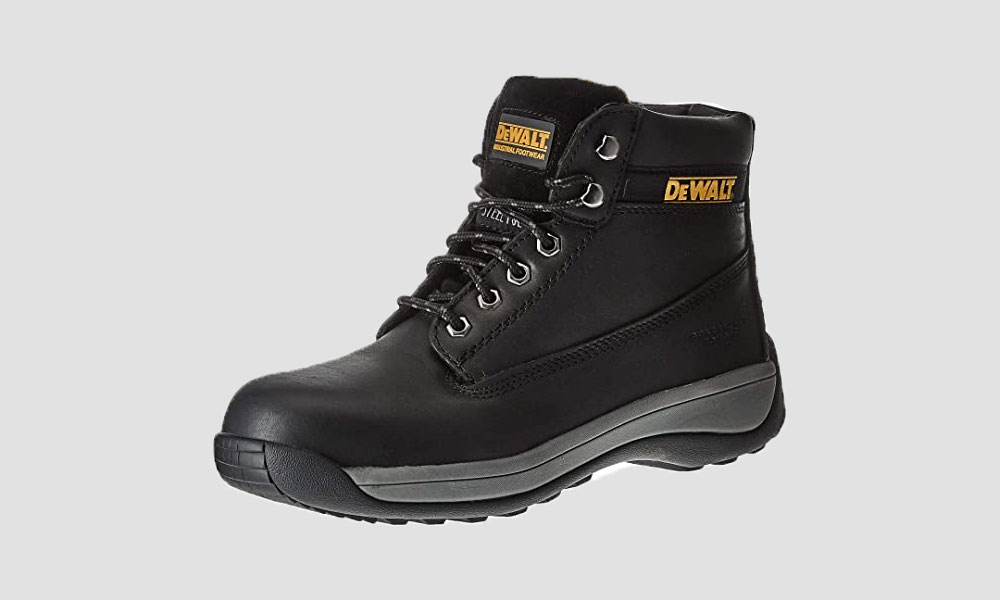
Of course, trainers are comfortable; you need something that wears hard and protects your feet from all manner of hazards. The Apprentice demonstrates expert design in this regard, with a robust rubber outsole rated for electrical resistance and heat resistance up to 300°. What’s more, the steel toe cap is tested to withstand up to 200 joules of energy from crushing and impact.
Together with the outsole, the full-grain leather upper repels oil and water alike, and features superior chemical resistance. The tread also bears an SRA slip rating, which retains a good grip even on soapy ceramic floors.
Inside, your feet will enjoy maximum comfort thanks the layering of dual-density PU/memory foam insole upon EVA midsole. What’s more, the insole is anti-bacterial, helping you stave off athlete’s foot, fungus, and other nasty afflictions of busy feet. The Apprentice also helps you keep stable with a TPU heel support. All together, these features work to absorb the energy of impact from your feet hitting the ground, helping you work longer hours with less pain.
DeWalt Apprentice at a glance
- Steel toe cap, EVA midsole
- Anti-bacterial insoles
- Extremely comfortable over long hours
- SRA anti-slip
- Easy break-in
- Affordable
What people are saying about Apprentice safety boots
People who own Apprentice work boots love them so much, it’s not unusual to see people on their 5th pair. This doesn’t mean they wear out quickly, only that people are comfortable enough to spend decades of their lives protected within one of DeWalt’s best safety boots.
While the Apprentice doesn’t have some of the more advanced safety features like a steel midsole, they still offer great protections overall–especially for the price. Considering DeWalt guarantees your purchase for a year, the Apprentice offers great value for money.
Be aware that the toe cap isn’t as spacious as some may like, so keep this in mind when choosing your safety boot.
7. DeWalt Camden
Finally, we come to the Camden, DeWalt’s answer to anyone looking for industrial footwear that doesn’t look too bulky or technical. Camden may be easy on the eyes, but they’re tough against the hazards which threaten your feet on or off the job.
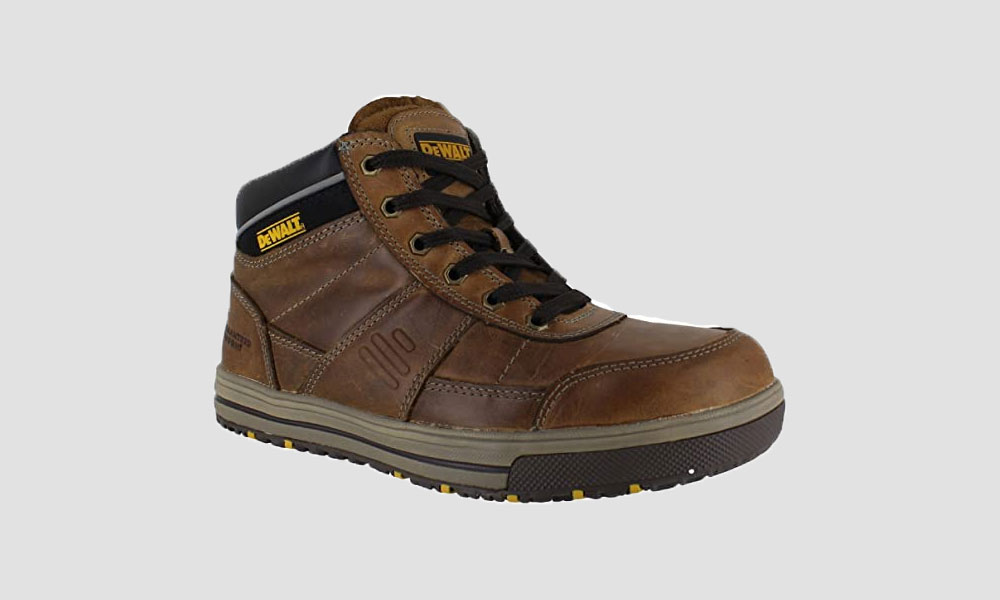
For starters, Camden’s steel toe actually exceeds the American ATSM standards, and will effectively guard your feet against all manner of kinetic damage. Similarly, they meet U.S. testing for electrical protection vs. open circuits.
As with most of DeWalt’s offerings, you’ll find a tough Nubuck full-grain leather comprising the smartly-constructed uppers. Lining the collar and tongue is a generous portion of padding, keeping the boot snug without pinching or cutting off circulation with the laces pulled tight. Inside is a moisture-wicking liner that works with the anti-bacterial insole to keep your feet healthy and dry.
Of all our recommendations on this list of the best safety boots, the Camden is the lightest weight. They stylish and comfortable to where you’d be happy to continue wearing them long after you’re off the clock. Nevertheless, they won’t let you down when accidents happen.
DeWalt Camden at a glance
- Lightweight and stylish
- Extra-strong steel toe cap
- Good electrical resistance
- Extremely comfortable with quick break-in
What people are saying about Camden safety boots
Defying appearances, the cap actually has plenty of room for your toes. In fact, owner reviews regularly tout how comfortable their Camden safety boots are, even over 8-hour stretches of physical labour. Somehow, DeWalt’s managed to make a work boot that feels as good to wear as it looks!
We’ve mentioned that Camden meets with American safety standards, but sadly that doesn’t fully translate to European standards. You’ll be fine with the toe cap in most cases, but if your job requires a specific level of electrical, chemical, or slip resistance, best find something with the necessary qualifications to get through the red tape. Don’t forget there’s no steel midsole, either.
Also, while the Camdens are indeed rugged, they’re necessarily more streamlined so as to offer up a greater sense of style. This means they’re not as hard-wearing as other entries on our list, so be sure to keep this in mind if durability is your top concern.
The anatomy of a work boot
Boot reviews (this one included) tend to assume you already know a bit about what goes into making a quality boot. But if you feel lost in the terminology, we’ll sort you out. Here below, we’ll briefly introduce the anatomy of a safety boot, and why it matters.
Uppers
A shoe or boot’s upper refers to the material which covers your foot and leg. With safety boots, these tend to consist of leather, but can incorporate various types of rubber and plastic as well. Uppers may be cut as a single piece, or bonded together from several smaller components.
- If your uppers are not a single piece, they may consist of any or all of these components:
- The vamp covers the toes and metatarsals, and is where the steel toe cap resides.
- The counter covers the heel to provide extra protection, support, and rigidity.
- The shaft covers the instep of the foot, and is typically where the lacing eyelets connect to the boot.
- Not every boot has a gusset, but those that do typically employ them as moisture barriers, which connect the tongue to the shaft.
Additionally, pay attention to the design of the cuff around the top of the uppers. Typically speaking, safety boot cuffs will have lots of padding to afford a more snug, secure fit. Otherwise, they risk rubbing your Achilles tendon raw.
Soles
A work boot’s sole is literally where the rubber meets the road. Typically speaking, the soles will consist of three layers:
- Outsole – This is, apart from the uppers, the most visible part of the boot, and certainly the most rugged. They’re typically made from PVC or proprietary rubber compounds, and are primarily designed to provide grip, alongside resistance to electricity and chemicals.
- Midsole – Many people don’t even know this part exists, as it’s nestled between the outsole and the insole. However, a good midsole provides vital cushioning and shock absorption; without it, you’d find your work boots utterly exhausting to wear for hours on end.
- Insole – You’re likely already familiar with insoles, as there’s a wide variety of aftermarket insole replacements recommended by orthopaedists available for purchase. A work boot’s insole will typically consist of pliant material which moulds to the shape of your foot–thus facilitating the transfer the energy of footfall into the midsole. It is also common for insoles to have some sort of anti-microbial treatment to keep your feet healthy and dry.
- Ribs and lugs – These adorn the bottom of your outsole to give you traction. Typically, you’ll want to opt for lugs for clinging to rough terrain, ladder rungs, and other dry surfaces. Ribs, on the other hand, offer a wider distribution of frictive surface area, and are thus better at gripping onto slick surfaces beneath snow, oil, mud, or standing water. Of the two, lugs are more robust and tend to last longer. Many safety boots offer hybrid treads for all-weather applications.
Construction
While this is a general term to describe how a boot is made, the industry often uses it as a term to specifically denote how the uppers join to the sole. There are three primary methods used in boot making:
- Welts – There are several types of welts out there, but the most common is the Goodyear welt and its waterproofed variant, the Storm welt. The easiest way to explain a welt is that the upper and sole are stitched together. This provides a sturdy mechanical bond, and tends to increase the stiffness of the boot. A worn out, welted sole can be replaced by a cobbler as long as the uppers are in good shape.
- Cementing – Essentially, cemented construction boots glue the uppers between layers of the sole with a powerful bonding agent. This yields a lighter, more flexible boot that doesn’t cost as much as a Goodyear welt. They’re not as durable, and it’s less cost-effective to have a cobbler replace cemented soles that are past their prime.
- Direct attach – With the direct attach method, a mould is made to fit the underside of the uppers. This mould is then filled with a molten rubber, which hardens with the uppers embedded inside. More durable than cement but less durable than a welt, this is a good midrange option that allows for superior stability and mobility.
Best safety boot materials
So now that you know a bit more about how a safety boot is made, what are they made of? There’s no shortage of acronyms to describe the virtues of this boot or another, but that’s useless if you don’t have a context for them. Let’s address a few key materials:
Full-grain leather
This is the material of choice for most safety boot uppers, due to the fact that it wears hard, requires little maintenance, and looks better with age. In fact, this is the best grade of leather for any purpose, as it makes use of the entire animal skin. Other grades, like top-grain or genuine leather, split the skin into its constituent layers as a cost-cutting measure.
Full-grain is naturally water-resistant. It can have tumbled, Nubuck, and suede finishes.
EVA
Ethylene-vinyl acetate is a manmade polymer used primarily as a shock absorber. It is a low-density material filled with tiny air bubbles which compress as your foot hits the ground. While it does wear out with time, it’s a common choice in boot making as it is extremely comfortable and thus reduces foot fatigue. It’s mostly found in work boot midsoles.
PU
Polyurethane is an organic polymer, and a common alternative to EVA midsoles. Unlike its softer counterpart, PU retains no shape memory, and doesn’t really compress much. While this is a less comfortable, less cushioning material, it’s far more durable.
TPU
Thermoplastic polyurethane is a miracle material which occupies the space somewhere between plastic and rubber. It’s flexible, strong, and has a good grip. It is most often found adorning work boots as a bumper along the heel or toe, but many models use it for their outsoles, as well.
PVC
Polyvinyl chloride is another common outsole material, due to its resistance to oils, abrasions, and electricity. It’s not as grippy as TPU or other rubber compounds; as such PVC outsoles tend to have novel tread designs or make use of other materials for traction.
How to care for your safety boots
Most safety boots are leather products, and as such require a bit of care to ensure their longevity. Here are a few quick tips to get the most out of your uppers:
- Keep them clean. You don’t necessarily need special cleaning compounds (though they make the job easier), just wipe the leather down with a damp cloth to remove dirt and grime. Nubuck and suede finishes will require a stiff bristled brush to effectively clean.
- Let them air out. Leather needs time to “rest”, which is to say they need time to rid themselves of moisture. Many boots feature waterproof treatments and moisture wicking liners to reduce the resting time needed. Nevertheless, store your boots in a cool, dry place when you’re not wearing them, and with cedar boot trees if you have one. Never use heat to dry your boots, as they’ll become brittle and crack.
- Regularly condition the leather. Every few weeks, you’ll want to apply some wax or oil conditioner to the leather uppers to keep them supple and strong. You should do this immediately after cleaning.
- Remove debris from the treads. Unless you’ve got a welted boot, the sole is usually the first thing to give out. You can extend the life of your soles by removing any nails, pebbles, dirt, or debris from between the treads or under the insole. Left in place, debris increases the amount of strain the rubber must endure, wearing them out faster.
Conclusion
DeWalt is a titan of heavy industrial gear, and their safety boots are well-regarded as such. Whether you need the maximum amount of protection, with steel toes and midsoles, or something lightweight to withstand miles of walking, climbing, and lifting, DeWalt safety boots make the cut.
We’ve reviewed the seven best DeWalt work boots in depth according to their comfort, fit, build, looks, and of course, protective measures. Each one occupies its own niche, and will serve as the perfect tool for its job.
What is your experience with DeWalt safety boots?
Have you owned any of our recommended models, or do you have your own favourite to recommend?
Let us know in a comment below!
My Titanium boots are certainly not waterproof – walking in wet grass and I get damp toes. Disappointed as they are very comfortable.
What model do you own, Steve?